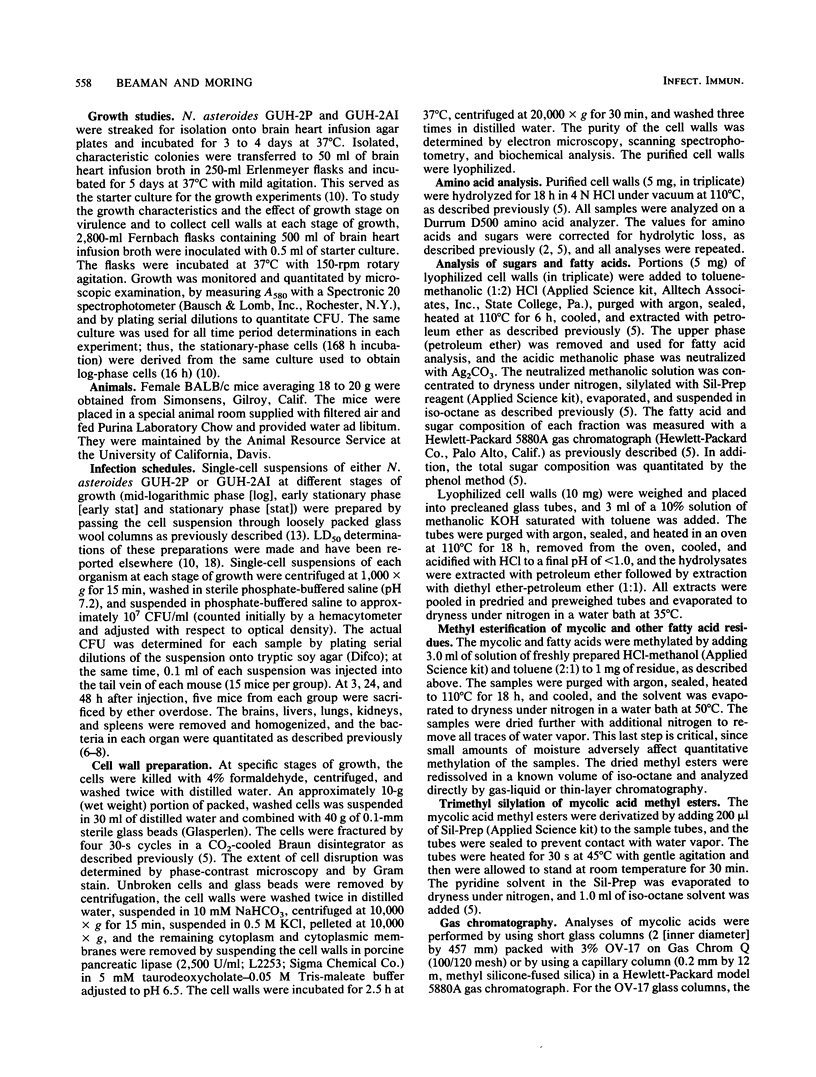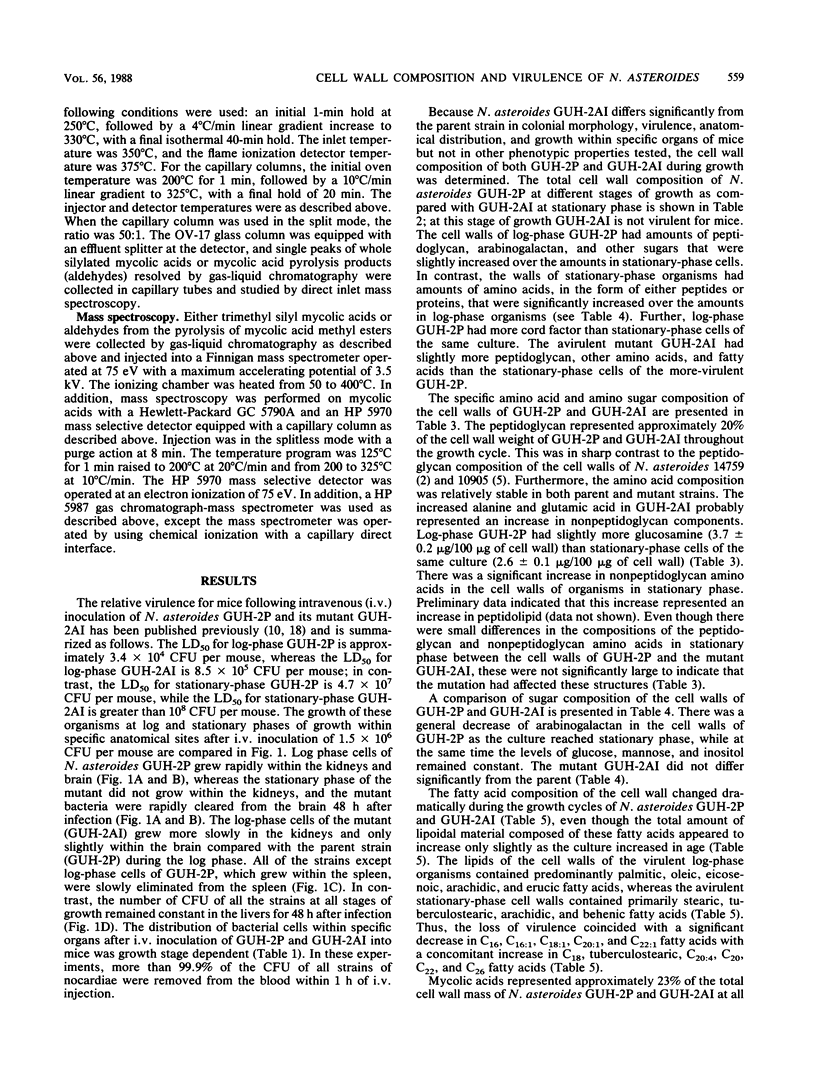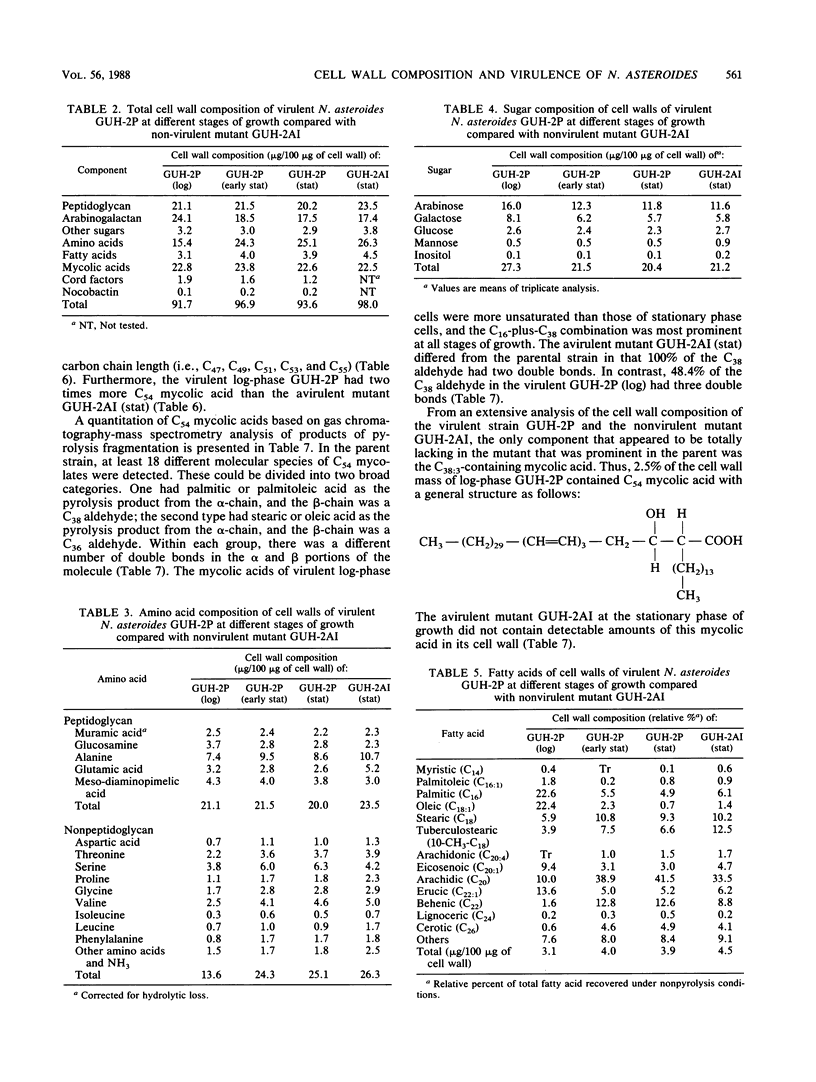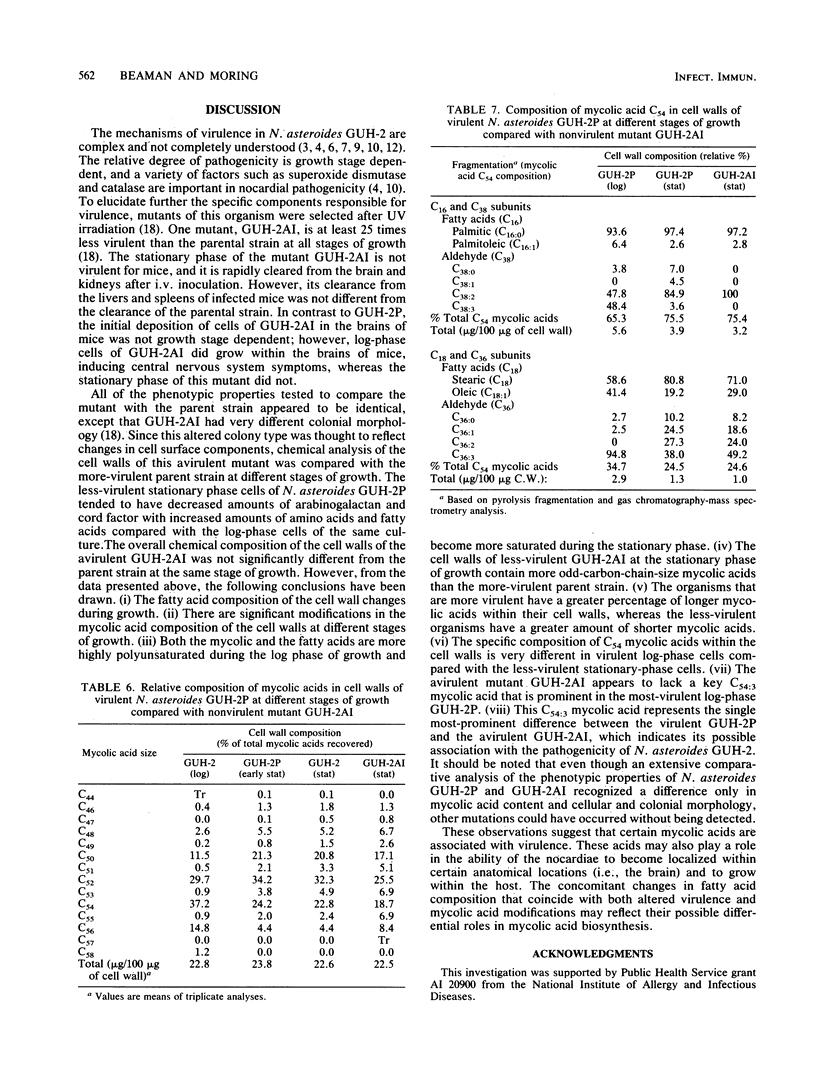Abstract
The clearance and organ distribution of virulent Nocardia asteroides GUH-2P and the avirulent mutant GUH-2AI at different stages of growth was determined after intravenous inoculation into BALB/c mice. The mutant differed significantly from the parent strain in its ability to survive and grow within the murine host. Since the mutant GUH-2AI had a very different colonial morphology compared with GUH-2P, it was believed that cell surface components might be affected by the mutation that resulted in the loss of virulence. Therefore, cell walls of both GUH-2P and GUH-2AI at different stages of growth were prepared and their composition determined. There were growth-stage-dependent changes in the composition of the cell walls that appeared to correlate with concurrent alterations in virulence; however, the overall chemical composition of the cell wall of the mutant (GUH-2AI) was not significantly different from that of the parent strain (GUH-2P). Both strains demonstrated significant modifications in fatty and mycolic acid composition at different stages of growth. Furthermore, the specific composition of C54 mycolic acids was very different in virulent log-phase cells compared with less-virulent stationary-phase cells, and the avirulent mutant lacked a C54:3 mycolate that was prominent in the virulent log-phase GUH-2P. Thus, C54:3 mycolic acid represented 2.5% of the cell wall (dry weight) in log-phase GUH-2P, but it was undetectable in the walls of GUH-2AI at the stationary phase of growth. These results suggest that certain mycolic acids are associated with virulence.
Full text
PDF






Selected References
These references are in PubMed. This may not be the complete list of references from this article.
- Azuma I., Kanetsuna F., Tanaka Y., Mera M., Yanagihara Y. Partial chemical characterization of the cell wall of Nocardia asteroides strain 131. Jpn J Microbiol. 1973 Mar;17(2):154–159. doi: 10.1111/j.1348-0421.1973.tb00720.x. [DOI] [PubMed] [Google Scholar]
- Beaman B. L., Black C. M., Doughty F., Beaman L. Role of superoxide dismutase and catalase as determinants of pathogenicity of Nocardia asteroides: importance in resistance to microbicidal activities of human polymorphonuclear neutrophils. Infect Immun. 1985 Jan;47(1):135–141. doi: 10.1128/iai.47.1.135-141.1985. [DOI] [PMC free article] [PubMed] [Google Scholar]
- Beaman B. L., Bourgeois A. L., Moring S. E. Cell wall modification resulting from in vitro induction of L-phase variants of Nocardia asteroides. J Bacteriol. 1981 Nov;148(2):600–609. doi: 10.1128/jb.148.2.600-609.1981. [DOI] [PMC free article] [PubMed] [Google Scholar]
- Beaman B. L., Gershwin M. E., Maslan S. Infectious agents in immunodeficient murine models: pathogenicity of Nocardia asteroides in congenitally athymic (nude) and hereditarily asplenic (Dh/+) mice. Infect Immun. 1978 May;20(2):381–387. doi: 10.1128/iai.20.2.381-387.1978. [DOI] [PMC free article] [PubMed] [Google Scholar]
- Beaman B. L., Gershwin M. E., Scates S. S., Ohsugi Y. Immunobiology of germfree mice infected with Nocardia asteroides. Infect Immun. 1980 Aug;29(2):733–743. doi: 10.1128/iai.29.2.733-743.1980. [DOI] [PMC free article] [PubMed] [Google Scholar]
- Beaman B. L., Goldstein E., Gershwin M. E., Maslan S., Lippert W. Lung response to congenitally athymic (nude), heterozygous, and Swiss Webster mice to aerogenic and intranasal infection by Nocardia asteroides. Infect Immun. 1978 Dec;22(3):867–877. doi: 10.1128/iai.22.3.867-877.1978. [DOI] [PMC free article] [PubMed] [Google Scholar]
- Beaman B. L. Interaction of Nocardia asteroides at different phases of growth with in vitro-maintained macrophages obtained from the lungs of normal and immunized rabbits. Infect Immun. 1979 Oct;26(1):355–361. doi: 10.1128/iai.26.1.355-361.1979. [DOI] [PMC free article] [PubMed] [Google Scholar]
- Beaman B. L., Maslan S. Effect of cyclophosphamide on experimental Nocardia asteroides infection in mice. Infect Immun. 1977 Jun;16(3):995–1004. doi: 10.1128/iai.16.3.995-1004.1977. [DOI] [PMC free article] [PubMed] [Google Scholar]
- Beaman B. L., Maslan S. Virulence of Nocardia asteroides during its growth cycle. Infect Immun. 1978 Apr;20(1):290–295. doi: 10.1128/iai.20.1.290-295.1978. [DOI] [PMC free article] [PubMed] [Google Scholar]
- Beaman B. L. Structural and biochemical alterations of Nocardia asteroides cell walls during its growth cycle. J Bacteriol. 1975 Sep;123(3):1235–1253. doi: 10.1128/jb.123.3.1235-1253.1975. [DOI] [PMC free article] [PubMed] [Google Scholar]
- Bordet C., Michel G. Structure et biogenèse des lipides a haut poids moléculaire de Nocardia asteroides. Bull Soc Chim Biol (Paris) 1969 Jul 25;51(3):527–548. [PubMed] [Google Scholar]
- Davis-Scibienski C., Beaman B. L. Interaction of Nocardia asteroides with rabbit alveolar macrophages: effect of growth phase and viability on phagosome-lysosome fusion. Infect Immun. 1980 Jul;29(1):24–29. doi: 10.1128/iai.29.1.24-29.1980. [DOI] [PMC free article] [PubMed] [Google Scholar]
- Deem R. L., Beaman B. L., Gershwin M. E. Adoptive transfer of immunity to Nocardia asteroides in nude mice. Infect Immun. 1982 Dec;38(3):914–920. doi: 10.1128/iai.38.3.914-920.1982. [DOI] [PMC free article] [PubMed] [Google Scholar]
- Minnikin D. E., Goodfellow M. Lipid composition in the classification and identification of acid-fast bacteria. Soc Appl Bacteriol Symp Ser. 1980;8:189–256. [PubMed] [Google Scholar]
- Tomiyasu I. Mycolic acid composition and thermally adaptative changes in Nocardia asteroides. J Bacteriol. 1982 Aug;151(2):828–837. doi: 10.1128/jb.151.2.828-837.1982. [DOI] [PMC free article] [PubMed] [Google Scholar]
- Vacheron M. J., Guinand M., Michel G., Ghuysen J. M. Structural investigations on cell walls of Nocardia sp. The wall lipid and peptidoglycan moieties of Nocardia kirovani. Eur J Biochem. 1972 Aug 18;29(1):156–166. doi: 10.1111/j.1432-1033.1972.tb01970.x. [DOI] [PubMed] [Google Scholar]
- Vistica C. A., Beaman B. L. Pathogenic and virulence characterization of colonial mutants of Nocardia asteroides GUH-2. Can J Microbiol. 1983 Sep;29(9):1126–1135. doi: 10.1139/m83-173. [DOI] [PubMed] [Google Scholar]
- Yano I., Kageyama K., Ohno Y., Masui M., Kusunose E., Kusunose M., Akimori N. Separation and analysis of molecular species of mycolic acids in Nocardia and related taxa by gas chromatography mass spectrometry. Biomed Mass Spectrom. 1978 Jan;5(1):14–24. doi: 10.1002/bms.1200050104. [DOI] [PubMed] [Google Scholar]


